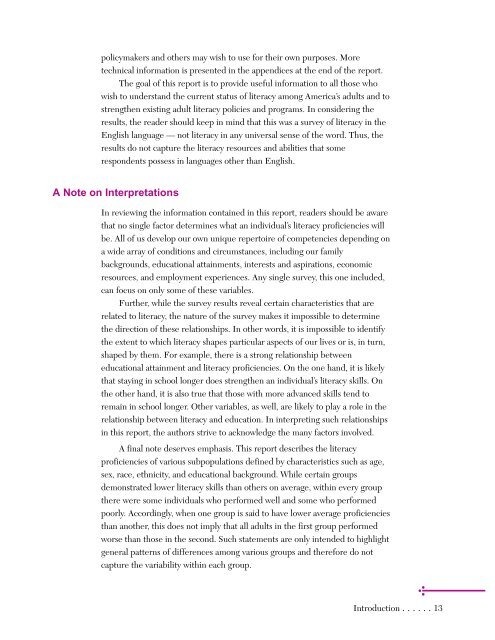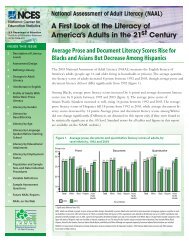Adult Literacy in America - National Center for Education Statistics ...
Adult Literacy in America - National Center for Education Statistics ...
Adult Literacy in America - National Center for Education Statistics ...
You also want an ePaper? Increase the reach of your titles
YUMPU automatically turns print PDFs into web optimized ePapers that Google loves.
policymakers and others may wish to use <strong>for</strong> their own purposes. More<br />
technical <strong>in</strong><strong>for</strong>mation is presented <strong>in</strong> the appendices at the end of the report.<br />
The goal of this report is to provide useful <strong>in</strong><strong>for</strong>mation to all those who<br />
wish to understand the current status of literacy among <strong>America</strong>’s adults and to<br />
strengthen exist<strong>in</strong>g adult literacy policies and programs. In consider<strong>in</strong>g the<br />
results, the reader should keep <strong>in</strong> m<strong>in</strong>d that this was a survey of literacy <strong>in</strong> the<br />
English language — not literacy <strong>in</strong> any universal sense of the word. Thus, the<br />
results do not capture the literacy resources and abilities that some<br />
respondents possess <strong>in</strong> languages other than English.<br />
A Note on Interpretations<br />
In review<strong>in</strong>g the <strong>in</strong><strong>for</strong>mation conta<strong>in</strong>ed <strong>in</strong> this report, readers should be aware<br />
that no s<strong>in</strong>gle factor determ<strong>in</strong>es what an <strong>in</strong>dividual’s literacy proficiencies will<br />
be. All of us develop our own unique repertoire of competencies depend<strong>in</strong>g on<br />
a wide array of conditions and circumstances, <strong>in</strong>clud<strong>in</strong>g our family<br />
backgrounds, educational atta<strong>in</strong>ments, <strong>in</strong>terests and aspirations, economic<br />
resources, and employment experiences. Any s<strong>in</strong>gle survey, this one <strong>in</strong>cluded,<br />
can focus on only some of these variables.<br />
Further, while the survey results reveal certa<strong>in</strong> characteristics that are<br />
related to literacy, the nature of the survey makes it impossible to determ<strong>in</strong>e<br />
the direction of these relationships. In other words, it is impossible to identify<br />
the extent to which literacy shapes particular aspects of our lives or is, <strong>in</strong> turn,<br />
shaped by them. For example, there is a strong relationship between<br />
educational atta<strong>in</strong>ment and literacy proficiencies. On the one hand, it is likely<br />
that stay<strong>in</strong>g <strong>in</strong> school longer does strengthen an <strong>in</strong>dividual’s literacy skills. On<br />
the other hand, it is also true that those with more advanced skills tend to<br />
rema<strong>in</strong> <strong>in</strong> school longer. Other variables, as well, are likely to play a role <strong>in</strong> the<br />
relationship between literacy and education. In <strong>in</strong>terpret<strong>in</strong>g such relationships<br />
<strong>in</strong> this report, the authors strive to acknowledge the many factors <strong>in</strong>volved.<br />
A f<strong>in</strong>al note deserves emphasis. This report describes the literacy<br />
proficiencies of various subpopulations def<strong>in</strong>ed by characteristics such as age,<br />
sex, race, ethnicity, and educational background. While certa<strong>in</strong> groups<br />
demonstrated lower literacy skills than others on average, with<strong>in</strong> every group<br />
there were some <strong>in</strong>dividuals who per<strong>for</strong>med well and some who per<strong>for</strong>med<br />
poorly. Accord<strong>in</strong>gly, when one group is said to have lower average proficiencies<br />
than another, this does not imply that all adults <strong>in</strong> the first group per<strong>for</strong>med<br />
worse than those <strong>in</strong> the second. Such statements are only <strong>in</strong>tended to highlight<br />
general patterns of differences among various groups and there<strong>for</strong>e do not<br />
capture the variability with<strong>in</strong> each group.<br />
Introduction ......13



